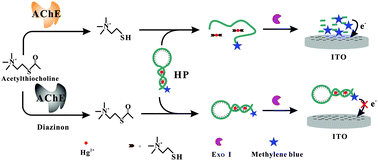Exonuclease I-aided homogeneous electrochemical strategy for organophosphorus pesticide detection based on enzyme inhibition integrated with a DNA conformational switch†
Abstract
A novel enzyme inhibition-based homogeneous electrochemical biosensing strategy was designed for an organophosphorus pesticide assay based on exploiting the resistance of a mercury ion-mediated helper probe (HP) toward nuclease-catalyzed digestion and the remarkable diffusivity difference between HPs and the mononucleotides toward a negatively charged indium tin oxide (ITO) electrode. In particular, the mercury ion-mediated T–Hg2+–T base pairs facilitate the HP labeled with methylene blue (MB) to fold into a hairpin structure, preventing its digestion by exonuclease I, and thus resulting in a low electrochemical response because of the large electrostatic repulsion between the negatively charged ITO electrode and the HPs. The competitive binding by a thiol group (–SH), produced in the hydrolysis reaction of acetylthiocholine (ACh) chloride with acetylcholinesterase (AChE), removes mercury ions from the base pairs, causing a nuclease-catalyzed digestion, and the subsequent electrochemical response increase due to the weak electrostatic repulsion between the product-mononucleotides and the ITO electrode. Mercury ion-mediated HPs were first designed for pesticide detection and diazinon was chosen as the model target. Under the optimal experimental conditions, the approach exhibited high sensitivity for diazinon detection with a detection limit of 0.25 μg L−1. The satisfactory results in the determination of diazinon in real samples demonstrate that the method possesses great potential for detecting organophosphorus pesticides. This new approach is expected to promote the exploitation of mercury-mediated base pair-based homogenous electrochemical biosensors in biochemical studies and in the food safety field.


 Please wait while we load your content...
Please wait while we load your content...